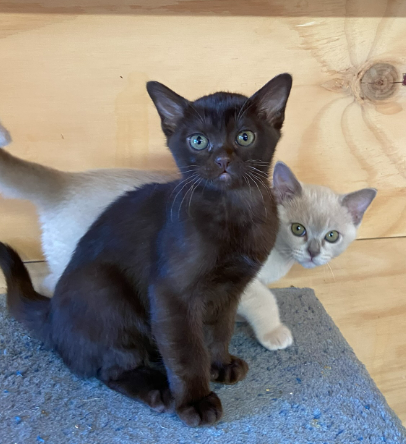About Burmese and Mandalay Cats
- miriamm00
- Feb 27
- 2 min read
The Burmese group is made up of Burmese, Mandalay, Bombay, Burmilla and Tiffany breeds and the Tonkinese is also mentioned as this is a hybrid of a Siamese and Burmese. The Burmese is a medium size, solid built cat oozing with personality. Burmese are pointed due to the “Burmese gene” (cbcb) which causes lightening of the fur in the warmer parts of the body.
Personality is what makes the breed popular, Burmese are playful and people orientated and have dog-like qualities. The Burmese is an intelligent, affectionate and adaptable cat that’s very playful and interacts well with their human slaves and especially loves being played with by children. Very early on they will teach their humans to play fetch and tag. It is said that Burmese remain kittens all their lives.
Burmese are great companions to their humans, other cats and also dogs, they’re great therapy cats and are amazing with children making them the perfect family pet. Burmese are also very adventurous, excellent hunters and climbers and will travel great distances to explore their environment which is a real safety issue for them in cities that now have small section sizes and busier roads
The “Burmese gene” (cbcb) causes lightening of the fur in the warmer parts of the body and is different from the Siamese “Himalayan” gene which causes albinism of the warm areas. The Mandalay is the same genotype as a Burmese apart from the lack of the “Burmese” gene which results in a “self” coloured or solid coloured cat (CC or Cc). This is similar to the cross between a Siamese and Oriental with respect to the Himalayan gene except that breeders haven’t yet ventured into bi-colour territory (why not?). The Burmese gene also causes some roughening of the hair shaft so the coat doesn’t feel as smooth and shiny as the non-pointed “self” coloured Mandalay. Coat colour genetics will be discussed in more detail later.
The Burmese is a small to medium size breed about 4-6 kg but muscular and active and should feel heavy for its size when held. They’re often described as a “brick wrapped in silk”. The coat is short, fine and glossy with a lighter undercarriage with darker points on ears, face, legs and tail. Barring or spotting is considered a fault although this may be minimal in a cream or red. Eyes are yellow to amber and Mandalay eye colour can extend to gold.
Burmese have been crossed with other breeds to bring in variations in coat, for example, crossed with the American Shorthair in America, the Domestic shorthair in the UK and the original cross in New Zealand and the British Shorthair in Australia to produce a solid colour or “self” cat called a Bombay, American Bombay (which are very similar)- both only come in black or Mandalay which comes in any solid colour of the Burmese (to be discussed later). The out-cross with the Persian creates a longer coat -in New Zealand is called a Tiffany or crossed with a Chinchilla Persian to create a Burmilla (which can be short or long haired). There is a difference between countries in how these crosses occurred and how they’re named. Coat colour genetics also drives the differences between the Burmese and the other breeds in this group.

References:



Comments